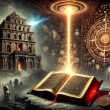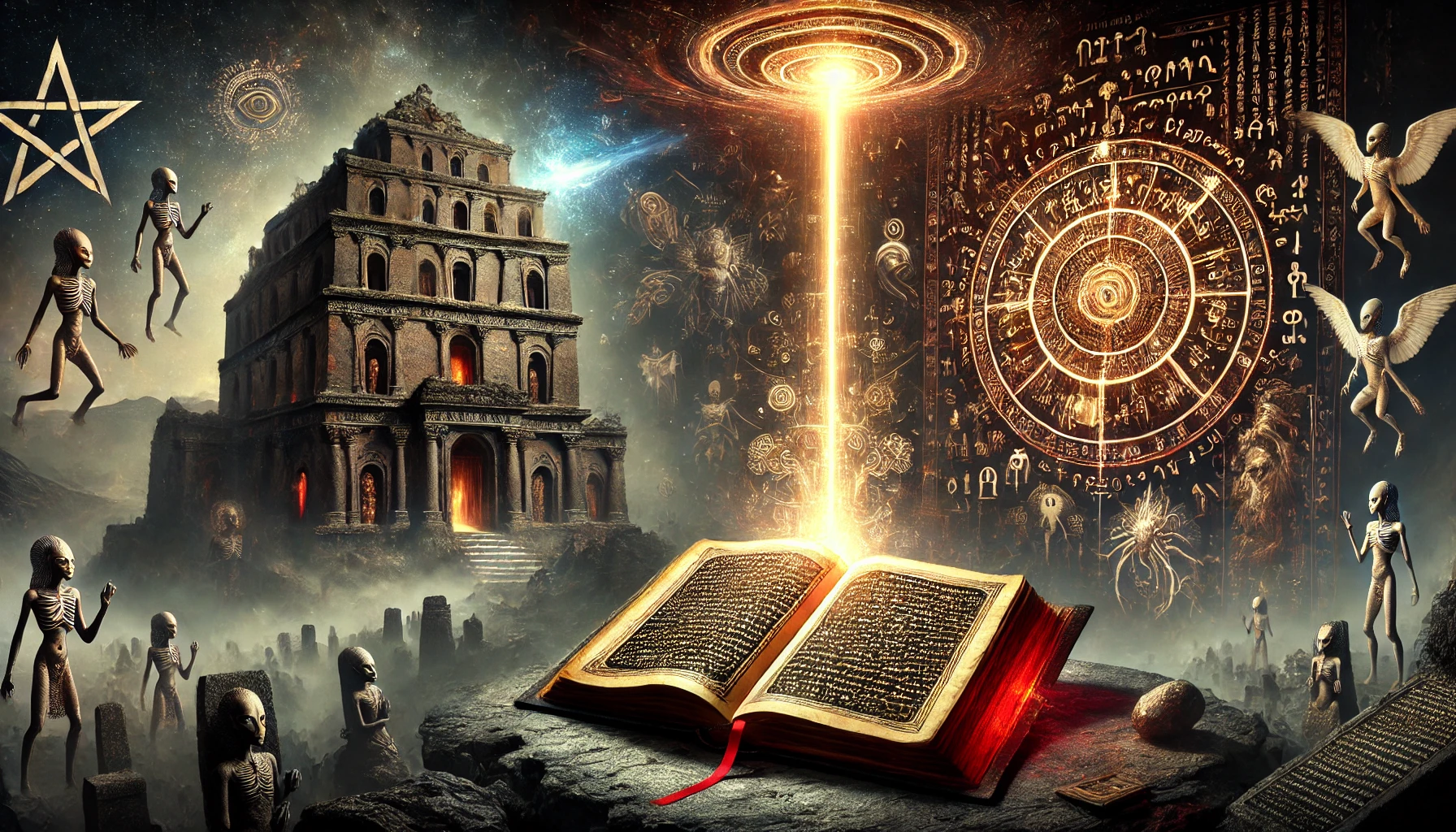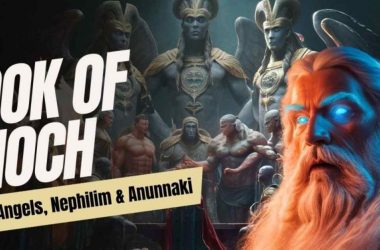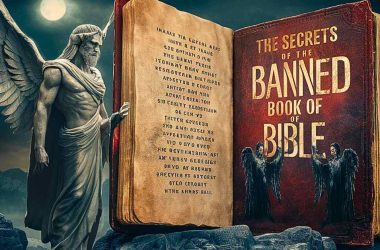In the misty highlands of Ethiopia, a remote monastery safeguards a centuries-old secret: a beautifully illustrated gospel manuscript believed to be the world’s oldest Christian book.
Legend tells of Abba Garima, a 5th-century monk who arrived from Constantinople in 494 AD and copied the Gospels in a single day – with divine help delaying the sunset
This incredible relic, known as the Garima Gospels, offers a glimpse into Ethiopia’s rich biblical heritage. At the heart of that heritage stands the Ethiopian Bible, a collection of scriptures unlike any other in the world.
Often called the Ge’ez Bible (after its ancient language), the Ethiopian Bible has been preserved by the Ethiopian Orthodox Church since the 4th century.

Many consider it the oldest and most complete Bible on Earth, as it predates the King James Version by nearly 800 years and contains a far larger canon of scriptures. While most Western Bibles have 66 books, the Ethiopian Orthodox Bible encompasses 81 books (46 in the Old Testament and 35 in the New)
Remarkably, it includes numerous texts that were excluded or lost from other Bibles over time – ancient books like Enoch, Jubilees, and others that survive fully only in Ethiopia
What secrets does this oldest Bible hold, and why has it been kept out of sight for so long? Let’s explore the origins, contents, and mysteries of the Ethiopian Bible, and discover what makes it so unique in the realm of sacred lore.
Ancient Origins in the Land of Ge’ez
Ethiopia was among the first regions in the world to embrace Christianity, dating back to the Aksumite Empire in the 4th century. The Ethiopian Bible emerged during this era, written in Ge’ez, a liturgical language now used only in Ethiopian church services. Ge’ez is an ancient South Semitic tongue indigenous to the Horn of Africa
By translating holy scriptures into Ge’ez, Ethiopian scholars made the Bible accessible to their people in their own language long before Latin or English Bibles took shape. In fact, the complete Ethiopic Bible was likely compiled by the 5th century, making it over a thousand years older than early English Bibles like the King James Version (1611).
This antiquity is one reason the Ethiopian Bible is often described as the “oldest complete Christian Bible in existence” Hand-copied onto parchment and guarded in monasteries, the text was passed down through generations. The survival of manuscripts like the Garima Gospels – carbon-dated to between the 4th and 7th centuries attests to Ethiopia’s early biblical tradition.

Thanks to the dry climate and careful guardianship, these manuscripts remained intact when many others perished. The Ethiopian Orthodox Tewahedo Church considers this Bible a cornerstone of its faith, preserving not just the standard books but also a treasury of ancient writings that vanished elsewhere.
A Canon Like No Other: 81 Books in the Ethiopian Bible
One of the most startling differences about the Ethiopian Bible is its expanded canon. While Protestant Bibles have 66 books and Catholic Bibles 73, the Ethiopian Orthodox Bible contains 81 books.
The broadest biblical canon in Christianity. This includes all the books familiar to other Christians plus a wealth of additional scriptures. The Church divides these into 46 Old Testament and 35 New Testament books
So, what are these extra books? Below are some of the noteworthy texts found in the Ethiopian Bible but absent from most Western Bibles:
- The Book of Enoch (1 Enoch): An ancient Jewish text attributed to Enoch (great-grandfather of Noah), full of apocalyptic visions and angelic lore. Once widely read, it was later excluded from Jewish and Christian canons. The Ethiopian Church kept it, making Ethiopia the only country with a complete biblical Book of Enoch in its canonocl.org. (Fragments of Enoch in Aramaic were discovered among the Dead Sea Scrolls, confirming its antiquity and importance.)
- The Book of Jubilees: A retelling of Genesis and Exodus events, also known as “Little Genesis.” It provides detailed chronologies and narratives of early biblical history. Jubilees was preserved in full only in Ge’ez – no complete Hebrew or Greek version survives – which means the world owes Ethiopia thanks for safeguarding this text
- 1, 2, and 3 Meqabyan (Ethiopian Maccabees): Three books of the Maccabees, different from the 1–2 Maccabees in Catholic Bibles. These books of heroes and wars are included in the Ethiopian Old Testament
- Baruch and Letter of Jeremiah: Books associated with the prophet Jeremiah, found in Catholic/Orthodox Old Testaments but often labeled apocryphal elsewhere. In the Ethiopian Bible they are fully canonicalocl.org (Baruch is included, as well as the letter attributed to Jeremiah).
- Ezra Kal and Nehemia (Ezra I & II and Ezra Sutuel): The Ethiopian canon has extra Ezra writings beyond the standard Book of Ezra and Nehemiah. These correspond to texts known as 2 Esdras (or 4 Ezra) and another Ezra apocalypse, which are absent in most Bibles.
- The Book of Josephus (Josippon) and others: The canon even extends to historical and church writings, like the Book of Josephas the son of Bengorion (an Ethiopic history of the Jews). In the New Testament section, it includes writings on church order and doctrine (e.g. Didascalia, Clement, and Sinodos)ethiopianorthodox.org, which are considered part of scripture in the Ethiopian tradition.
This rich collection highlights why the Ethiopian Bible is often described as the “complete” Bible – it retains many writings that other traditions either lost or intentionally left out. Books like Enoch and Jubilees were removed from mainstream Bibles after the early centuries of Christianity, deemed non-canonical by councils and theologians. Yet, Ethiopia never discarded these texts. As a result, scholars today can study these works in full thanks to Ethiopian manuscripts
The Ethiopian Church’s broader canon offers a fascinating alternate window into biblical history – one filled with mystical visions, angelic revelations, and ancient law that amplify the story we know from the standard Bible.
The Significance of Enoch and Jubilees in Ethiopian Scripture

Two of the most famous extra-canonical books, Enoch and Jubilees, hold special significance. The Book of Enoch profoundly influenced early Christian and Jewish beliefs about angels, demons, and the origins of evil. It describes the fall of a group of angels (the Watchers), their union with human women, and the rise of giants – themes that later inform biblical concepts of fallen angels and the Flood. Outside Ethiopia, Enoch was virtually forgotten for over a thousand years, surviving only in hints and fragments. But in the Ethiopian Bible, 1 Enoch is fully intact as a respected scripture. In fact, the only complete manuscript tradition of Enoch is in Ge’ez
This means Ethiopia preserved a “lost” book that had disappeared from Western Bibles. (Notably, when the Dead Sea Scrolls were discovered in the 20th century, several copies of Enoch were found in the Qumran caves, proving that ancient Jewish communities held it in high esteem – just as the Ethiopian Church did.)
Likewise, the Book of Jubilees is invaluable for understanding early biblical interpretation. Jubilees rewrites the book of Genesis with extra details – for example, naming the wives of patriarchs, detailing a solar calendar, and emphasizing sabbath observance. It was known in antiquity (early Christian writers referenced it), but later fell out of circulation. Only the Ethiopian Bible preserved Jubilees in its entirety
Fragments from Qumran show that Jubilees was once widespread in Hebrew yet had Ethiopia not kept its Ge’ez version, modern scholars might never have reconstructed the full text. The inclusion of Enoch, Jubilees, and other “lost books” in the canon sets the Ethiopian Bible apart and has scholars and theologians re-examining the development of the biblical canon.
Why Was the Ethiopian Bible Forgotten by the West?
If the Ethiopian Bible is so complete and ancient, a curious question arises: Why do so few people know about it? For many centuries, the unique canon of the Ethiopian Church was largely unknown outside of Africa. Part of the reason is historical isolation – Ethiopia’s Christian tradition developed independently, and its scriptures weren’t widely translated into European languages. Additionally, when Western churches were formalizing their Bibles (through councils in the 4th–5th centuries and later during the Protestant Reformation), they excluded those extra Ethiopian books as “apocrypha” or “pseudepigrapha”. The result is that the Ethiopian Bible’s content was considered unconventional and was not integrated into Catholic or Protestant teaching.

In essence, the Ethiopian Bible wasn’t so much banned as it was ignored or dismissed by medieval Church authorities who had settled on a shorter canon. Over time, this led to the Ethiopian scriptures being sidelined from mainstream Christianity.
In fact, until modern times, most Christians (and even many scholars) had never heard of the Ethiopian Bible, or assumed it was just like the Western Bible
As one author put it, the Ethiopian Bible was “discredited and hidden” from view Only in the 19th and 20th centuries did Western scholars begin to seriously study the Ge’ez manuscripts, translating books like Enoch and Jubilees into English for the first time.
Political and cultural factors also played a role. During colonial times and the spread of European Christianity, the focus was on distributing the more familiar 66-book Bible. Ethiopia’s Bible of 81 books did not fit that colonial narrative. Some even speak of a deliberate effort to suppress or downplay the Ethiopian Bible because its contents (like Enoch’s stories of giants and angels) were seen as controversial or too mythical. Our article Why The Ethiopian Bible Got Banned? delves deeper into these historical intrigues. It explores how power dynamics in the early church led to certain books being labeled heretical or dangerous, and why Ethiopian scripture remained a well-kept secret in plain sight.
Yet, despite centuries of obscurity, the Ethiopian Bible endured within its homeland. The Ethiopian Orthodox Church continued using it in liturgy and teachings, never considering those books “forbidden” internally. This perseverance ensured that when the wider world was ready to explore these texts, they were still there waiting. Today, researchers and the faithful alike are turning to the Ethiopian Bible to shed light on early Christianity’s diversity. It’s a powerful reminder that history is written by the victors – but sometimes, precious pieces of our spiritual heritage survive on the margins, waiting to be rediscovered.
Legacy and Enduring Significance
The Ethiopian Bible is more than just a religious scripture; it’s a cultural treasure and a living link to the early centuries of faith. Its survival has profound implications. For believers, it confirms that God’s word can reach people in many forms – Ethiopia kept teachings that others lost, suggesting that what is canon can depend on one’s tradition. For scholars, the Ethiopian manuscripts (like those of Enoch, Jubilees, and the Gospels) provide critical evidence about the development of biblical texts. For example, the Ge’ez versions of certain books have helped compare and corroborate fragments found elsewhere, deepening our understanding of Judeo-Christian history
Moreover, the Ethiopian Bible has fueled imaginations and inspired mythological discussions. The inclusion of mystical books sparks questions: What other stories and knowledge lie within these pages? Tales of angels intermingling with humans, visions of heaven and hell, and detailed laws and calendrical cycles give the Ethiopian Bible an almost mythic aura. It bridges the gap between mainstream biblical narrative and the wider world of ancient Near Eastern lore. It’s no surprise that the Ethiopian Bible often features in conversations about “lost” or “forbidden” scriptures in popular culture. Even topics like mermaids in the Bible have been explored through the Book of Enoch’s lens (see our article Mermaids in the Bible: The Shocking Revelations from the Book of Enoch for a fascinating example of how Enoch’s texts inspire modern lore discussions!).
Importantly, for the Ethiopian people, this Bible is a source of national pride and identity. Ethiopia’s resilience in keeping Christianity alive through wars, isolation, and attempts at suppression is symbolized by this ancient Bible. It stands as a testament to a faith that withstood the test of time. Today, as more of the world learns about the Ethiopian Bible, there is growing respect for Ethiopia’s role in preserving early Christian writings. Efforts are underway to digitize manuscripts and translate them, so that the wider public can finally read these long-hidden books.
In summary, the Ethiopian Bible opens a door to a version of biblical truth that is both familiar and fantastically extra-dimensional. It reminds us that the Bible was not always a fixed collection of 66 books, but a dynamic library of sacred stories that different communities treasured. Exploring the Ethiopian Bible allows us to travel back to an older era of Christianity – one where the boundaries of scripture were still fluid and expansive. It challenges and enriches our understanding of biblical lore and invites us to consider the full tapestry of texts that have informed faith over millennia.
Conclusion – A Living Legacy: The Ethiopian Bible’s story is still unfolding. As scholars continue to unravel its Ge’ez texts and as curiosity about apocryphal books grows, this ancient Bible is finally stepping into the global spotlight. For those who love myths, history, and spirituality, the Ethiopian Bible is a thrilling discovery – the closest thing to a time capsule of early Christian lore. If you’re eager to learn more, don’t hesitate to dive into the sources and even read translations of books like Enoch and Jubilees yourself. The journey is well worth it.
What do you think of the Ethiopian Bible and its forbidden books? Did any of its contents surprise you, or do you have questions about its stories? Join the conversation by leaving a comment below! And if you found this exploration enlightening, please share it with others who might be intrigued by the mysteries of ancient scriptures. Together, let’s keep the spirit of discovery alive.
References
LoreLibrary Myth – Mermaids in the Bible: The Shocking Revelations from the Book of Enoch: Article examining the Book of Enoch’s content (e.g. references to mermaid-like creatures) and its significance as a “missing” biblical book.
Ethiopian Orthodox Tewahedo Church – Canonical Books: Official list of the 81 books in the Ethiopic Bible
OCL (Orthodox Christian Laity) – Ethiopian Bible is the oldest and complete bible on earth: News article highlighting the age and contents of the Ethiopian Bible (800 years older than KJV; includes Enoch, Jubilees, etc.)
Amazon (Prince, 2022) – Ethiopian Bible: A Detailed History…: Descriptive summary noting the Ethiopian Bible as the oldest complete Bible, preserved since the 4th century and written in Ge’ez.
Wikipedia – Book of Jubilees: Explains how Jubilees was found among the Dead Sea Scrolls and survives fully only in Ge’ez (Ethiopian Bible).
LoreLibrary Myth – Why The Ethiopian Bible Got Banned?: In-depth article on our site exploring historical reasons why the Ethiopian Bible was excluded from mainstream canon.
Shop amazing Anunnaki Merchandise at our store, Follow us on Facebook, Instagram, And For More Interesting Content Also Subscribe To Our Youtube Channel.







